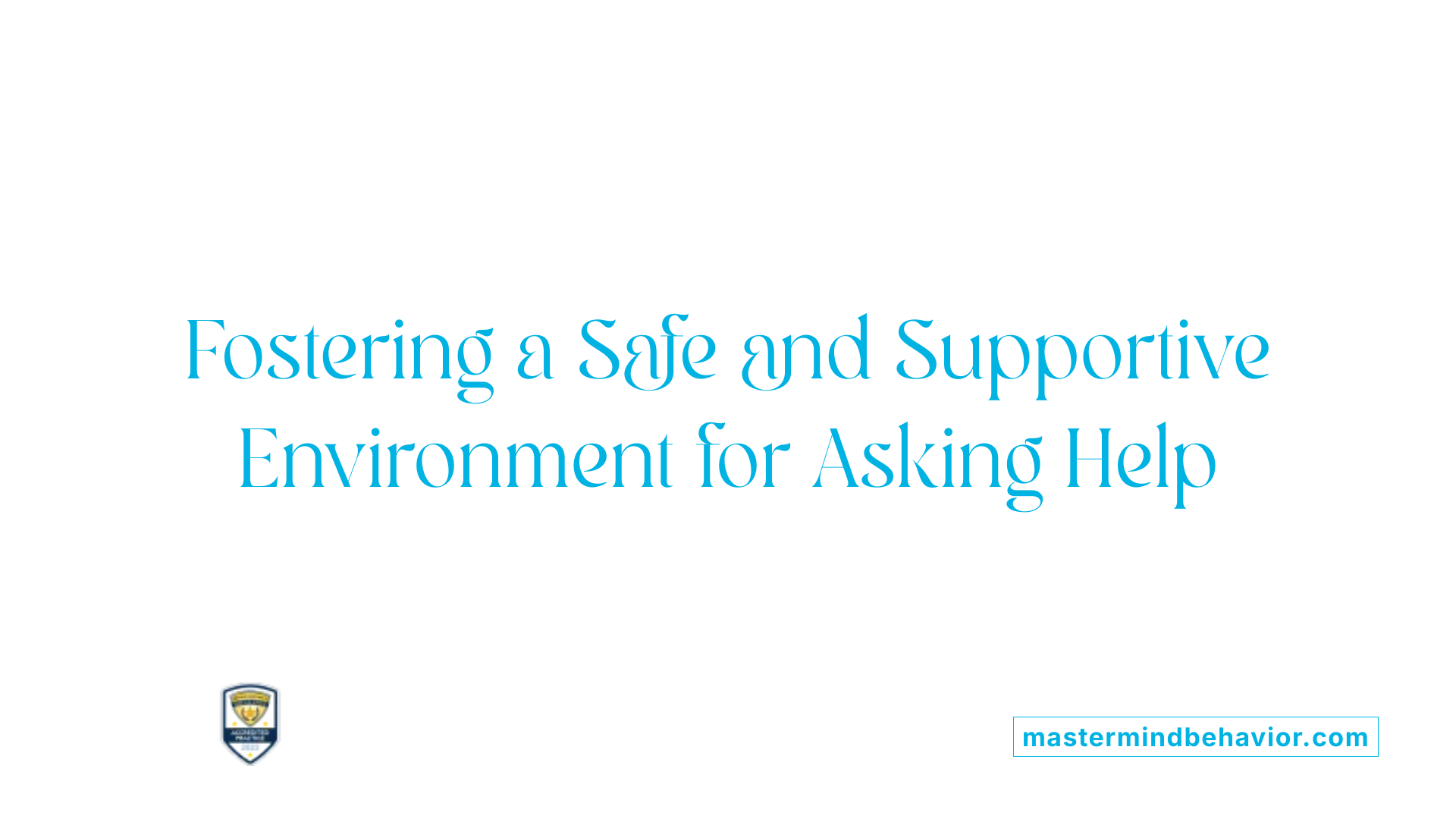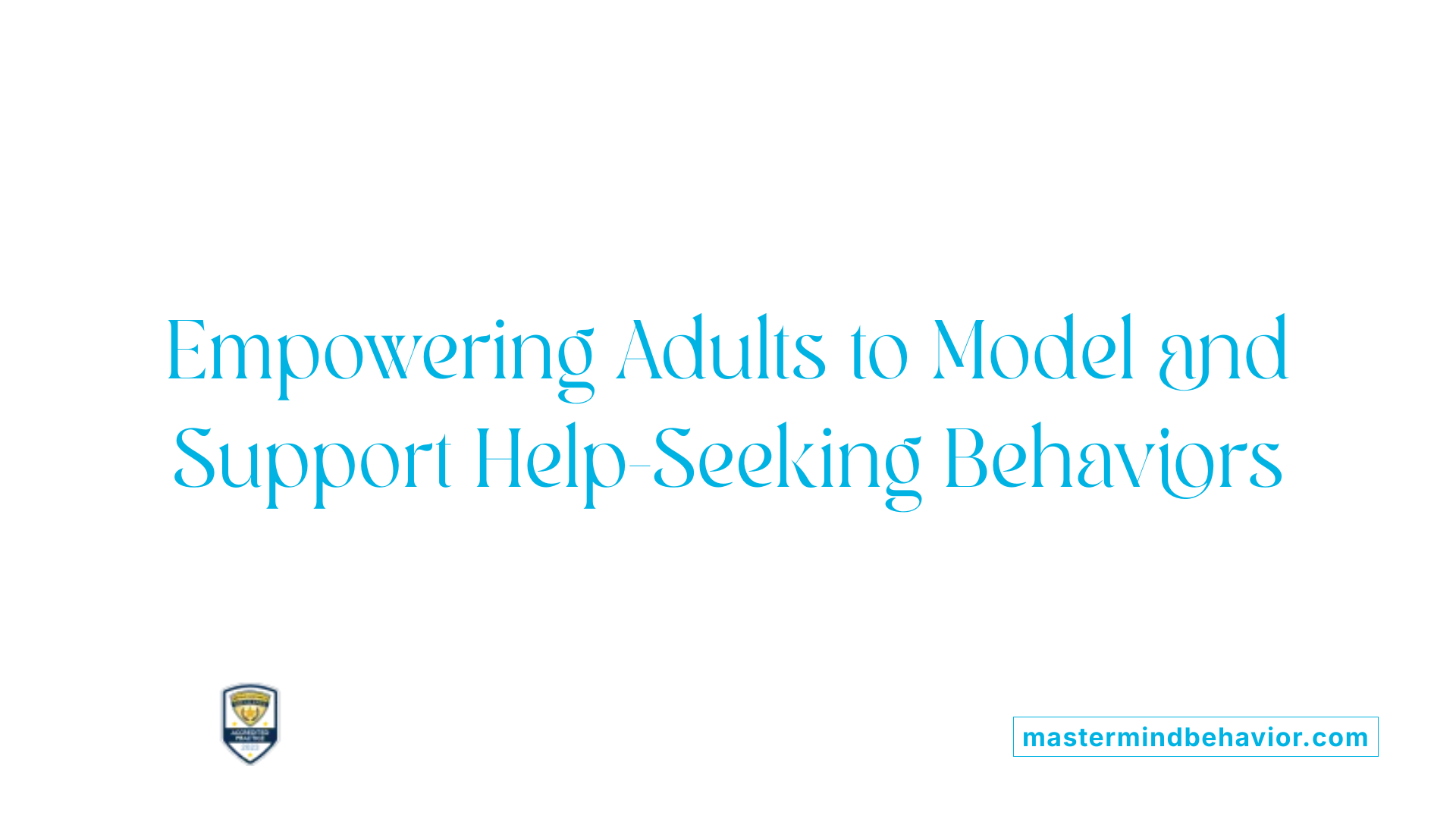How to teach children to ask for help appropriately

Building Confidence and Independence in Children
Teaching children how to ask for help appropriately is a vital component of social-emotional development. It fosters independence, resilience, and problem-solving skills that support their growth into self-sufficient individuals. This article explores practical strategies, activities, and developmental considerations for caregivers and educators seeking to cultivate healthy help-seeking behaviors among children, ensuring they feel safe, supported, and confident to seek assistance when needed.
Understanding the Emotional Barriers to Asking for Help

Why do some children struggle to ask for help?
Many children find it difficult to ask for help due to various emotional barriers rooted in their perceptions and feelings. One common reason is the fear of judgment or rejection. Children worry that admitting they need help might make them appear weak, incapable, or different from their peers. This concern about standing out or being laughed at can create feelings of embarrassment or shame.
Furthermore, social and cultural norms often play a role in discouraging children from showing vulnerability. In environments where independence and self-reliance are highly valued, asking for assistance can be seen as a sign of failure or inadequacy. Children raised with this mindset may feel that seeking help could lead to negative judgments.
Emotions such as anxiety and fear of judgment can significantly inhibit a child's willingness to reach out. Children with high expectations for themselves or those who tend toward perfectionism may interpret asking for help as a personal failure, increasing their reluctance. These emotional responses create internal barriers that make it harder for children to develop the confidence needed to seek assistance.
Understanding these feelings is crucial for caregivers. By recognizing that emotions like embarrassment and shame are barriers, adults can help children navigate these complex feelings. Normalizing help-seeking, providing positive reinforcement, and modeling open, supportive behaviors can reduce these emotional hurdles, making children more comfortable with asking for help whenever they need it.
The Power of Modeling and Trust in Help-Seeking Behaviors

How can caregivers and educators effectively teach children to ask for help?
Modeling help-seeking behavior and creating a trusting environment are vital. When adults openly demonstrate asking for help, children see it as a normal part of learning and social interaction. For example, a parent might verbalize their own process, saying, "I'm having trouble opening this jar; do you have any ideas?" This shows children that seeking assistance is acceptable and even helpful.
Encouraging children to see help-seeking as a positive action involves praise and reinforcement. When a child asks a question or requests help, acknowledging their courage boosts their confidence and signals that it's okay to seek support.
Role-playing activities are especially effective. Setting up scenarios where children practice asking for help in a safe, supportive environment can ease anxiety and build competence. For instance, children can pretend to need help with a puzzle or a classroom task, practicing polite asking strategies.
Highlighting instances when children help others fosters a reciprocal view of support — that helping and being helped are both valued behaviors. This mutual understanding reduces embarrassment and develops a culture of trust and cooperation.
Why is normalizing help-seeking important?
Normalizing help-seeking diminishes feelings of embarrassment or shame often associated with admitting difficulty. When children see adults and peers regularly asking for help, they internalize that it’s a sign of strength and maturity, not weakness.
Building trust and emotional safety ensures children feel secure enough to ask questions without fear of judgment. This foundation supports their emotional resilience and encourages ongoing help-seeking as a healthy coping skill.
Ultimately, fostering an environment where asking for help is normalized and modeled by adults helps children develop independence, problem-solving skills, and social confidence.
Engaging Activities to Teach Help-Seeking Skills

What are some activities to teach children to ask for help?
Engaging children in fun, structured activities is an effective way to teach help-seeking skills. Interactive games are particularly popular because they combine learning with play, encouraging children to practice asking for help in a safe environment.
Some recommended games include “Help Me Out,” “Ask the Expert,” “Helping Hands Relay,” and “Helping Puzzles.” Each of these activities is designed to promote communication, cooperation, and self-advocacy.
For example, in “Help Me Out,” children work together to solve problems, encouraging them to ask for assistance when they’re stuck. “Ask the Expert” involves role-play where children practice asking a trusted adult or peer for help in a realistic context. “Helping Hands Relay” is an active game that requires children to seek help from teammates to complete a task, fostering teamwork and help-seeking behaviors. With “Helping Puzzles,” children work on puzzles that vary in difficulty, prompting them to request help when needed.
Beyond games, curriculum-based resources like those from Everyday Speech offer video modeling and structured lessons that reinforce help-seeking skills. These lessons guide children step-by-step through scenarios, teaching them how to recognize the need for help, how to ask politely, and how to express gratitude.
Creating a positive, supportive atmosphere during these activities enhances their effectiveness. Clear instructions and encouragement help children feel comfortable asking for help, boosting their confidence for everyday situations.
By combining playful activities with real-world practice and appropriate resources, children can develop the social and emotional skills necessary to seek help effectively, ultimately fostering independence and resilience.
Creating a Supportive Environment for Help-Seeking

How can a supportive environment promote healthy help-seeking behaviors in children?
A nurturing and respectful atmosphere plays a crucial role in encouraging children to ask for help when they need it. When children feel safe and valued, they are more likely to express their emotions and seek assistance without fear of judgment or embarrassment. An environment rooted in empathy fosters trust, making it easier for children to share their feelings and challenges openly.
Positive social connections are also essential. When children build strong relationships with trusted adults and peers, they learn that support is available and that seeking help is a sign of strength. Educating children about mental health, emotional well-being, and effective communication reduces stigma and normalizes help-seeking behaviors.
Confidentiality and consistent support outside of classroom settings further reassure children that their concerns will be handled with care and respect. For example, one-on-one conversations and private check-ins allow children to voice worries they might not share publicly.
Creating an environment that values safety, respects individual needs, and promotes open communication helps children develop confidence in seeking help. Incorporating social-emotional learning strategies, conflict resolution skills, and mental health literacy fosters a community where help-seeking is understood as a positive, proactive step toward well-being.
In summary, a combined focus on physical safety, emotional security, trust-building, and social connectivity lays the foundation for children to feel comfortable and supported in asking for help whenever necessary.
Supporting Adults to Foster Help-Seeking Skills

How can adults support children in developing help-seeking skills?
Adults play a crucial role in helping children become comfortable with asking for help. By modeling positive help-seeking behaviors, such as openly admitting their own mistakes and seeking assistance when needed, adults normalize these actions and reduce the child's resistance or anxiety.
Creating a safe and trusting environment is essential. When children feel secure emotionally, they are more confident to express their needs. Adults should engage in developmentally appropriate communication, encouraging children to share their feelings and ask questions without fear of judgment. This involves using supportive language, active listening, and showing empathy.
Establishing routines and specific language helps children understand when and how they can ask for help. For example, setting designated times for questions or creating visual cues that signal help requests reinforces these behaviors.
Understanding the different stages of child development informs how adults can tailor their support. Younger children benefit from simple, clear prompts and role-playing, while older children can handle more complex problem-solving and discussions about when to seek assistance.
Building strong relationships through regular social interactions and collaborative problem-solving empowers children to feel more confident in their independence. Involving children in decision-making and respecting their preferences reinforces their sense of autonomy.
Reducing stigma around asking for help is vital. When support is framed positively—as a sign of strength and growth—children are more likely to seek it.
Supporting children from an early age to develop help-seeking habits sets the foundation for lifelong skills that enhance their emotional well-being, problem-solving abilities, and overall resilience. By fostering these skills early and consistently, adults can help children navigate challenges confidently as they grow.
Developmental Approaches to Help-Seeking Across Ages
How does developmental stage influence help-seeking behaviors in children?
Children's ability to ask for help evolves as they grow, influenced heavily by their developmental stage. In early childhood, kids are often dependent on adults for guidance. They may not yet recognize when they need help or understand how to ask for it. At this stage, modeling help-seeking behaviors by parents and teachers is essential. For example, showing children how to verbalize their need or using signals can make a difference.
As children mature, they develop better emotional understanding and communication skills. Older children learn to recognize internal cues like frustration or confusion and can ask for help more independently. They start to identify appropriate times and manners for seeking assistance, including understanding when to approach a teacher, a coach, or even peers.
Adolescents, meanwhile, become more socially aware and capable of self-advocacy. They can assess situations more critically, determine whether help is needed, and seek it from a variety of sources, including mental health professionals, depending on the context.
Social factors greatly influence these behaviors. A supportive environment with clear routines for help-seeking fosters confidence in children of all ages. In classrooms, routines like raising hands or using helper signals become part of the culture, making it easier for children to ask for help at appropriate times.
Overall, understanding how developmental stages shape help-seeking can guide caregivers and educators in providing tailored support, ensuring children learn to advocate for themselves effectively at each age.
Encouraging Growth Mindset and Independence in Help-Seeking
How can a supportive environment promote healthy help-seeking behaviors in children?
Creating a supportive environment is essential for fostering positive help-seeking habits among children. Such an environment is one where children feel safe, respected, and understood, encouraging them to share their struggles without fear of judgment. This involves building trust through consistent and empathetic interactions with adults and peers.
In practice, face-to-face conversations with caring, non-judgmental helpers help children express feelings comfortably. When children see that their concerns are taken seriously, they are more likely to ask questions and seek assistance. Confidentiality and privacy outside of school settings can also make children feel secure in reaching out.
Furthermore, positive social connections and teaching communication skills help normalize help-seeking. Reducing stigma around mental health and emotional struggles encourages children to view asking for help as a strength rather than a weakness. Incorporating strategies like peer support, conflict resolution training, and mental health literacy strengthens their confidence.
Overall, a holistic approach—covering emotional security, safety, and social support—lays a foundation that motivates children to seek help when needed, supporting their growth in resilience and autonomy.
Adapting Strategies for Children with Complex Needs
When working with children who have complex needs, it’s important to tailor approaches that support their unique developmental trajectories. Individualized support plans are essential, as they help define specific goals and strategies that match each child's abilities and challenges. These plans often include visual aids and alternative communication methods, such as picture boards, sign language, or assistive technology, to ensure children can express their needs effectively. This promotes confidence in asking for help and building independence.
Normalizing help-seeking behaviors for children with complex needs involves consistent modeling, practice, and reassurance. Adults play a critical role by demonstrating asking for help in everyday situations, highlighting that everyone needs support at times. Incorporating visual cues—like charts or symbols—can serve as prompts for children to seek assistance, especially in noisy or unfamiliar environments. These tools help children recognize when they need help and provide a clear pathway for requesting it.
What are effective ways to foster independence and a growth mindset around asking for help?
Building independence and encouraging a growth mindset require fostering a positive attitude towards help-seeking. This can be achieved by normalizing the behavior as a tool for learning and resilience. Praise for effort, persistence, and problem-solving—rather than just successful outcomes—reinforces the value of trying and seeking assistance.
Adults can model help-seeking in various ways, from asking for help themselves to sharing stories about overcoming difficulties. Teaching children to reframe setbacks using phrases like "not yet" or "I'm learning" nurtures patience and resilience. Creating opportunities for children to practice asking for help in low-pressure situations, such as during structured play or guided activities, builds confidence.
Supporting children to identify when and how to seek help, along with providing visual or physical prompts, helps them develop autonomy. This approach cultivates a mindset that views challenges as opportunities to grow, fostering both independence and resilience in children with complex needs.
Summing It Up: A Holistic Approach to Help-Seeking
Teaching children to ask for help appropriately is a multifaceted process that involves understanding their emotional development, modeling positive behaviors, creating a supportive environment, and engaging in targeted activities. Emphasizing trust, encouragement, and resilience helps foster a growth mindset that sees help-seeking as a strength, not a weakness. By applying these principles consistently, caregivers and educators can empower children to become confident, autonomous, and resilient individuals who understand when and how to seek assistance, ultimately supporting their overall well-being and success.
References
- How to Teach Kids It's Normal to Ask for Help & Make Mistakes
- How to Teach Children to Ask for Help
- Building Independence: Teaching Your Child When and How to Ask ...
- Teaching Your Child to Ask for Something | NFXF
- Four Fun Games to Teach Asking for Help with Students
- Teach Your Kids to Ask for Help – A Mother's Success Story
- How To Ask For Help & Teaching Growth Mindset To Kids
Recent articles

The Role Of ABA Therapy In Developing Self Determination Skills
Unlocking Independence: How ABA Therapy Empowers Self-Determination in Autism

ABA Therapy For Supporting Flexibility In New Social Groups
Enhancing Social Adaptability in Autism Through Applied Behavior Analysis

ABA Therapy For Increasing Peer Engagement During Play
Enhancing Social Interaction Through ABA Techniques in Autism Therapy

ABA Therapy For Increasing Peer Engagement During Play
Enhancing Social Interaction in Autism Through Play-Based ABA Therapy

ABA Therapy For Increasing Peer Engagement During Play
Enhancing Social Interaction in Autism Through Play-Based ABA Therapy

ABA Therapy For Increasing Peer Engagement During Play
Enhancing Social Interaction in Autism Through Play-Based ABA Therapy



